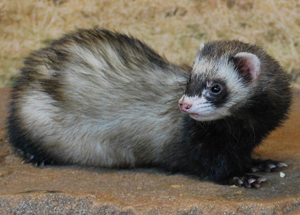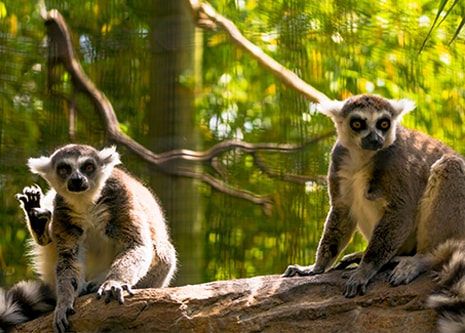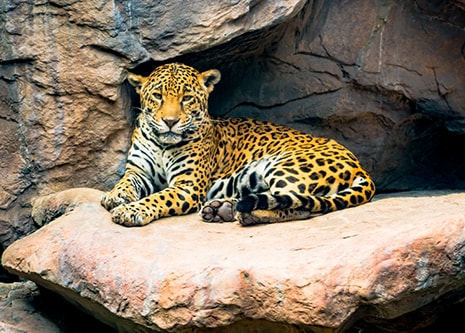
- VisitSupport Happy HollowDONATE TODAYExploreSupport Happy HollowDONATE TODAYLearnSupport Happy HollowDONATE TODAYSupport
-
Today's Hours: 10:00 am to 5:00 pm
Education AmbassadorsDomestic ferret

Scientific name: Mustela putorius furo
Family: Mustelidae
Order: Carnivora
Class: Mammalia
Range: Originally from Europe and Asia; domesticated worldwide
Habitat: Urban
Lifespan: 7 to 10 yearsWhat do they look like?
Ferrets are a domesticated form of polecat, and have been selectively bred to be larger and heavier than their wild counterparts. They have a long, sinuous body with relatively short legs, and long curved claws for digging and climbing. Their characteristic hunched gait keeps their sensitive nose close to the ground. Males, known as hobs, average around 20 inches long from nose to tail, while females, called jills, are smaller, usually around 15 inches long. They come in four basic colors: albino, cream, sable and silver, and may have different patterns and markings of white fur.How do they behave?
Wild polecats are solitary and range over a large home territory, which they defend from other polecats. Their flexible bodies make them adept at fitting into tight spaces, including rabbit warrens. Domestic ferrets prefer to live in groups, as they are social. Ferrets are crepuscular (most active at dawn and dusk) and spend about 16hours a day sleeping!What do they eat?
Ferrets are obligate carnivores, that is, they eat whole small prey, including the bones, organs, fur and feathers. They are efficient hunters of rodents, rabbits, small birds and snakes. At Happy Hollow, they eat mice.How are they born?
Ferrets are born hairless and blind, and dependent on their mother. She cares for her litter of two to seven kits for around three months. The kits reach sexual maturity by six months of age.What should you know about them?
Ferrets have been used by humans to hunt rabbits for centuries. More recently, some electricians have trained ferrets to carry wiring through tunnels. Ferrets are illegal to keep as pets in California and Hawaii. The local environment could provide all the necessities for ferrets to establish viable populations if released by irresponsible pet owners. If this were to happen, ferrets would become an invasive species, which means that they would negatively affect the ecosystem by competing with native species for resources and habitats.Conservation
Domestic ferrets have not been evaluated by the International Union for Conservation of Nature because they were bred by people and do not belong in the wild. However, North America is home to one species of indigenous ferret, called the black-footed ferret (Mustela nigripes). The black footed ferret was driven to the brink of extinction through habitat loss and disease, the last known wild population of 18 individuals was taken into captivity in 1985. Through breeding efforts conducted by the U.S. Fish and Wildlife Service and their affiliates, these animals have been successfully reintroduced to areas of the Midwest in the United States. They have made a miraculous comeback but their survival still remains in the hands of humans. The black-footed ferret’s conservation status is currently listed as Endangered by the IUCN. If you would like to help black-footed ferrets you can start by educating your friends about them. If you would like to take your conservation action a step further, visit www.worldwildlife.org/species/black-footed-ferret for more ways to help.
Zoo on the Hill
Located across from the Keep-Around Carousel is the Zoo on the Hill. Learn about wildlife up close during daily meet-and-greets, leap like a lemur on the playground, brush and feed the goats,, or take a peek inside Doc’s Critter Care building and the Ranch House. Double-H Ranch features a combination of animal exhibits, including giant anteaters and red ruffed lemurs, as well chickens and domesticated animals that are docile enough to touch.
See Animals
Zoo in the Hollow
Follow the crooked bamboo pathway down into the hollow and visit with some of the most amazing animals in the world. Where else in San José can you get up close to a stunning jaguar, lemur, meerkat or American alligator? Happy Hollow is dedicated to helping save species and preserve wildlife for future generations by participating in Species Survival Plan programs through the Association of Zoos and Aquariums.
See AnimalsVisit Us Today
Plan an unforgettable experience at San Jose’s family-friendly park and zoo.
more info